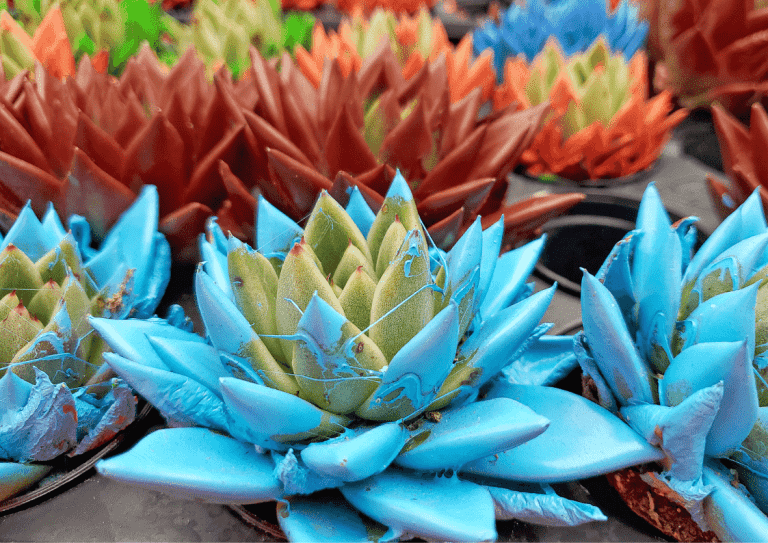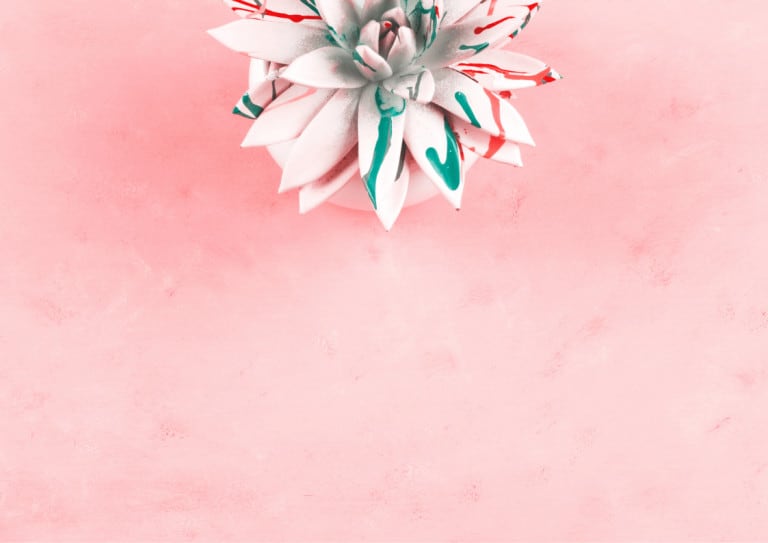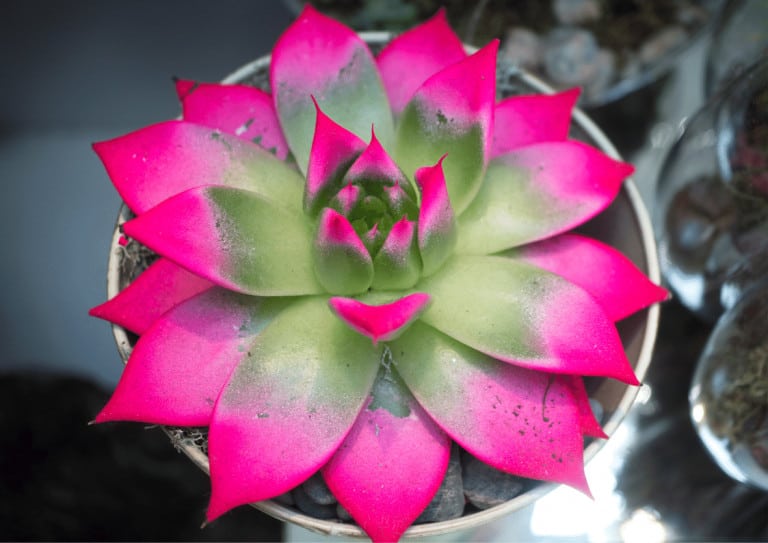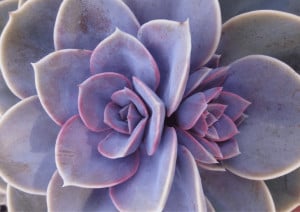How To Remove Paint From Painted Succulents? (Acrylic + Spray Paint)
- Lakeisha Ethans
- April 13, 2022
If you buy something using the retail links in our articles, sometimes we earn a small affiliate commission. This does not impact the products we recommend.
Painted succulents have been picking up a lot of traction over the past decade or so. With bright colors applied through a dip or spray method, the plants are made to appear more aesthetically pleasing in beautiful shades.
Supposedly, “non-toxic” and food-safe paints are used. But, of course, painting succulents is not the best idea for the health of those plants. If you have a painted succulent, you may want to find a way to remove that paint as quickly as possible.
The right way to remove paints from succulents depends on the type of paint used. Acrylic paint is typically water-based and spray paint is usually oil-based, and these bases have to be dissolved in different ways. Some spray paint may be latex-based, which also needs a unique removal process. Regardless, you’ll need a suitable solvent, clean cloth, and your commitment!
Some less strong or low-quality paints may fade on their own, but if you’re worried about your plants, it’s typically not a good idea to wait it out and hope for that result. You’ll need to do what you can to remove the paint, even with hardy plants like succulents.
It can feel difficult to get rid of paint since paint is designed to be permanent, but it’s actually a little easier than it seems. In this article, we’ll discuss some ways to do this by covering the following topics:
- Is painting succulents bad for them?
- How can you remove acrylic paint from succulents?
- How can you remove spray paint from succulents?
- Is it wrong to paint succulents?
This post will look into the best methods to get rid of paint from succulents and give you an overview of what you need to know about painted succulents.

Is painting succulents bad for them?
Painting succulents is universally bad for them. It’s a common misconception that paint always wears off on succulents. It’s also a common misconception that succulents are hardy and resistant enough to survive well even with painted leaves.
In reality, succulents will only be able to live for a few months after they’ve been painted, especially with thick spray paint. During this period, the naturally drought-resistant plants will use up their reserves of water and food to survive until they run dry – literally and metaphorically.
Horticulture expert Tiernach McDermott states that spraying succulents prevents them from being able to perform photosynthesis. The plants need to absorb sunlight to convert that into food and energy, and thick paint blocks out the sun from the plants. This can also block air, suffocating the plant more quickly.
There’s also the risk of the toxic chemicals in most paints affecting a succulent and making it sick. Plants can absorb dyes in paints and may wind up harming them and causing further suffocation.
Some succulents will live for a couple of years even with paint on them, typically if they have a lot of reserves and a little bit of exposed new growth that isn’t covered. However, the plant will not be healthy and will still eventually die at a much younger age than it could or should have achieved.
Our Favorite Succulents And Supplies On Etsy
How can you remove acrylic paint from succulents?
Acrylic paints are water-based and are relatively easy to remove. Simply start by taking a clean rag or piece of cloth. Microfiber cloths work best, but any soft cloth will do. Soak the cloth in some clean lukewarm water and wring it to remove any excessive moisture.
Then, use the wet cloth to rub at the plant’s leaves gently. Use one direction of movement in your cleaning strokes. Keep doing this for each individual affected leaf until the paint is entirely removed. If the paint is especially stubborn, you can also use a soft paintbrush instead of a cloth.
This may take a while, especially if you have a bigger succulent, and some acrylic paint will be tougher to get off. Still, the process is simple. You can use this method to remove any water-based paints from succulents.
Interestingly, acrylic paint is not as bad for succulents as spray paint. Due to its water-based nature, it’s not going to completely block out all air consumption and may even allow for some sun exposure. The paint is also more likely to fade with time.

How can you remove spray paint from succulents?
Spray paint can be made of many different compositions, but it’s most commonly oil-based. Organic solvents are typically needed to completely remove this kind of paint, but these solvents often have a risk of eroding and harming succulent leaves. At no point should you use items like polish remover, kerosene, thinners, or petrol on a succulent.
The best option you have as a solvent here is rubbing alcohol. This solvent will be able to dissolve the bonds between the paint molecules so that it can be taken off of the leaves. Start by taking a clean rag or piece of cloth. Soak the cloth in some rubbing alcohol and wring it to remove any excessive moisture.
With the cloth soaked in rubbing alcohol, use one single, firm stroke in a single direction to take off the paint. The alcohol should allow for this to be done smoothly. One stroke is all you need for each leaf and painted portion. Don’t overdo this with excessive rubbing.
If your succulent has nice, shiny leaves, it may be even easier to remove the paint, as the smooth leaf surface is difficult for oil-based paints to adhere to. Regardless, you can use this method to remove any oil-based paints from succulents.
Though rare, some spray paints are of a latex base, often marked with terms like “acrylic formula” – not to be confused with acrylic paint! Latex paint is technically water-based, but it uses additional compounds that make its core composition different and it has to be removed differently.
To remove latex spray paint from your succulent, simply flake the dried paint off gently with your fingers. Latex paint forms a rubbery layer that is dangerous for the plant but can be peeled away once dry. Just be sure not to use scrapers or even your nails, as this may damage the surface of your plant.
Of course, some modern spray paints are entirely water-based. For these paints, you can remove them the same way as acrylic paints. The bottom line is this: try and find out what kind of spray paint has been used before trying to remove it!

Is it bad to paint succulents?
It’s not good to paint succulents. It can definitely feel bad or wrong to paint them when you know that they’ll die as a result. It can feel like you’re hurting the plant, or from a more practical perspective, it can feel like a waste.
Admittedly, this is more of a moral question than anything else. At the end of the day, it’s up to you what you do with your personal plants. However, you must be prepared for the fact that your succulents simply will not be able to survive for very long if they are painted.
Some people opt to paint small dots or little patterns onto succulents in small and sparse areas. This supposedly allows the plant to continue its necessary functions and avoids harming them. However, it’s still not advisable if you want to ensure the very best health for your plant.
Of course, it goes without saying that if you plan to resell or sell succulents, you should not paint them and should aim to sell them naturally unless you are transparent about how long they will likely survive. You should also avoid painting or otherwise harming any endangered or threatened species of succulents.
Take home message
Painting succulents poses a significant risk to the plant, always ending with it dying due to an inability to photosynthesize or breathe within months. That’s why it’s a good idea to try and remove as much of this paint as possible, as soon as you can.
The paint may be water-based, oil-based, or latex type, and each one has a different method of paint removal. Water-based paint can be removed with cloth and water while oil-based paint needs a non-corrosive solvent and cloth. Finally, latex paint can be flaked off gently without any hard scrapers. If you do this well, you’ll be able to salvage your succulent!

Lakeisha Ethans
Houseplant Writer
Mother to two humans and hundreds of plant babies. Lakeisha uses her 15 years of experience as a content writer to specialise in simplifying what you need to know to grow and care for all indoor plants.
Similar Posts
41 Snake Plant Names So Funny, You’ll Struggle To Pick One
Why not give each plant in your houseplant collection their own unique name. Here are a list of funny names that you could give to your Snake plant.
The Secret To Cleaning Succulents With Farina
Removing fragile farina from a plant leaves it open to damage, so how can you properly and safely clean your succulent?



